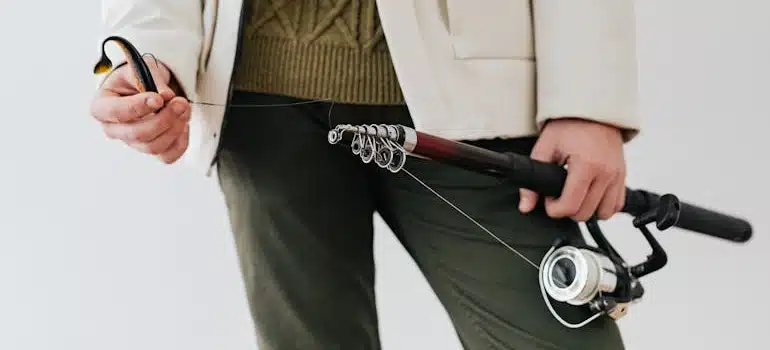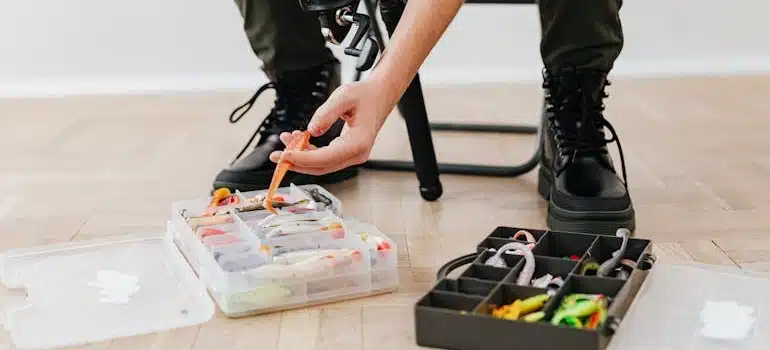How to pack fishing equipment for an interstate move?
Planning a move across state lines? If you own fishing equipment, packing it properly is key to avoiding damage and delays. Unlike clothes or books, rods, reels, and tackle require a more thoughtful approach. You don’t want your gear getting bent, rusted, or broken in transit. So, rely on our guide to walk you through how to pack fishing equipment for an interstate move with one of the best moving companies Miami offers.
1. Sort and prepare your fishing gear
Begin the packing process by laying out all your fishing gear in one place. Sort your rods, reels, tackle boxes, nets, tools, and small accessories into clear groups. It will help you see what you have and make packing more efficient.
Grouping items by type or usage, such as freshwater gear versus saltwater, or travel rods versus large casting setups, can help you pack in a more organized way and unpack faster once you arrive.
Clean and dry your fishing gear
This is also the ideal time to clean everything, just as you’d do when packing camping gear. Wipe down rods and reels to remove dirt or residue. If you’ve used saltwater gear, rinse off all components thoroughly and allow them to dry completely.
Salt and moisture can cause rust or corrosion if left on the surface during transit. Dry gear not only stays in better condition, but it also prevents mildew or odor from developing inside boxes or rod tubes.

Inventory in detail
Taking inventory is equally important. Snap a few photos of your most valuable items, especially any high-end rods, custom reels, or rare lures. Keep a list of what you’re packing and make a few notes about the condition of each item. If your shipment gets damaged or lost, having this record on hand can speed up insurance claims and help you recover losses.
2. Disassemble rods and reels
Break your rods down into their smallest sections before packing. Most rods are either two-piece or telescopic, which makes them easier to transport. Take the reel off each rod and set it aside. Wrap each rod section on its own to prevent scratches or pressure damage. Use padded rod sleeves if you have them. If not, a soft towel or bubble wrap works well for each piece.
Pack the reels separately. If you still have the original box, use it. If not, wrap the reel in foam or thick padding and place it in a small, sturdy box. Make sure nothing shifts around inside. Tape down loose parts or fill gaps with packing paper. Securing every item this way helps avoid damage during handling and long-haul loading.
3. Use proper protection for rods
Fishing rods are lightweight but fragile. You don’t want to just toss them in a moving box. Instead, use a dedicated rod tube or hard case. These cases are designed to absorb shock and protect against pressure.
If you don’t have a rod case:
- Bundle rods together using soft padding between each one
- Slide them into a PVC pipe or a thick cardboard mailing tube
- Seal both ends tightly and label the container as “fragile.”
It will keep the rods from bending or snapping during loading and unloading. It also gives movers a clear visual cue to handle that item with extra care, which helps reduce the risk of breakage in a busy moving environment.
The same goes for packing any hunting gear: even a small amount of pressure in the wrong spot can cause permanent damage, so it’s worth taking the extra time to secure it properly.

4. Secure tackle and sharp accessories
Hooks, knives, and lures can easily cause injury or damage to other items if not packed correctly. Start by going through your tackle box. Remove sharp items and place them in secure compartments.
Here’s a good method to follow:
- Use a tackle box with locking lids and foam inserts
- Wrap individual lures in tissue or plastic before placing them inside
- Pack tools like pliers or fillet knives in a separate pouch
Also, as you pack fishing equipment for an interstate move, double-check that liquids like bait scents or reel oils are sealed and stored upright.
5. Pack items into a sturdy moving box
After prepping each piece, you can start boxing things up. Use small to medium-sized moving boxes. Don’t overpack as fishing gear is lighter than it looks, and overstuffing can cause breakage.
Line the box with crumpled packing paper or peanuts to create a cushion. Place reels, tools, and tackle boxes in the center. Add more padding around the sides and top. Close the box securely with packing tape, and clearly label it as “Fishing Equipment – Fragile.”
6. Communicate with your moving company
Fishing gear requires special handling—especially when moving long distance. Before moving day, it helps to speak with your movers about how you plan to transport your equipment and what support they can provide.
Talk to your local interstate movers
In coastal cities like Miami, it’s common for residents to own fishing gear, especially for weekend trips to Biscayne Bay or offshore charters. If you’re working with interstate moving companies in Miami, let them know upfront that you plan to pack fishing equipment for an interstate move. Not all movers are familiar with handling rods, reels, and tackle, so it’s important to confirm how your gear will be loaded, secured, and transported.
Consider moving expensive gear separately
Always ask your movers if they have weight restrictions for long containers like rod tubes or if they offer added protection for fragile sporting items. Some may use extra padding or provide custom packing options for high-value gear. If you’re relocating with particularly expensive or rare equipment, consider keeping it with you in your vehicle or shipping it separately.

7. Know the TSA rules if you’re flying with fishing gear
If your interstate move includes air travel—either for yourself or for some of your gear—it’s important to know what the Transportation Security Administration (TSA) allows. While some fishing items can go in your carry-on, others are better suited for checked baggage. Here’s a quick breakdown to help you pack correctly and avoid hold-ups at the airport:
- Fishing rods: Allowed in carry-on if they fit within airline size limits; safer in a checked hard case.
- Reels: Allowed in both carry-on and checked bags. Wrap them well if packed separately.
- Hooks and lures: Allowed in carry-on at TSA officer discretion. Sharp or large hooks should go in checked baggage.
- Tackle boxes: Carry-on is allowed, but contents must meet TSA standards (no knives, no large liquids).
- Fishing line: Permitted in both carry-on and checked luggage.
Check with your airline before you travel, especially for size limits on rod cases. TSA officers have final authority, so packing sharp or oversized items in your checked bag is always the safer choice.
Also, check whether your moving company offers moving insurance that covers sporting equipment. Standard coverage might not fully protect the value of custom rods or premium reels. If you’re concerned about damage or loss, ask about full-value protection or third-party coverage options.
FAQs about other ways to move fishing equipment
If you’re not sending your gear with movers—maybe you’re flying ahead or relocating separately—you might be wondering about alternative transport options. Below are common questions people ask when moving fishing equipment by air or shipping services.
Q: Can you take a fishing rod on a plane as hand luggage?
A: Yes, but only if the rod fits within your airline’s carry-on size limits. Most airlines allow it, but double-check with the carrier.
Q: Can you bring fishing lures and hooks on a plane?
A: You can pack them in checked baggage. Some small lures may be allowed in carry-on, but TSA officers make the final decision.
Q: What’s the best fishing rod case for air travel?
A: Hard-shell rod tubes or airline-approved cases offer the most protection. Choose one with internal padding.
Q: How much does it cost to bring fishing rods on a plane?
A: Costs vary by airline. Some include them as part of your checked baggage allowance, while others may charge oversize fees.
Q: Is shipping fishing gear a good idea?
A: If you’re not moving with a truck, shipping can be an option. Use FedEx or UPS with insurance and tracking. For high-value gear, this can add security and flexibility.
